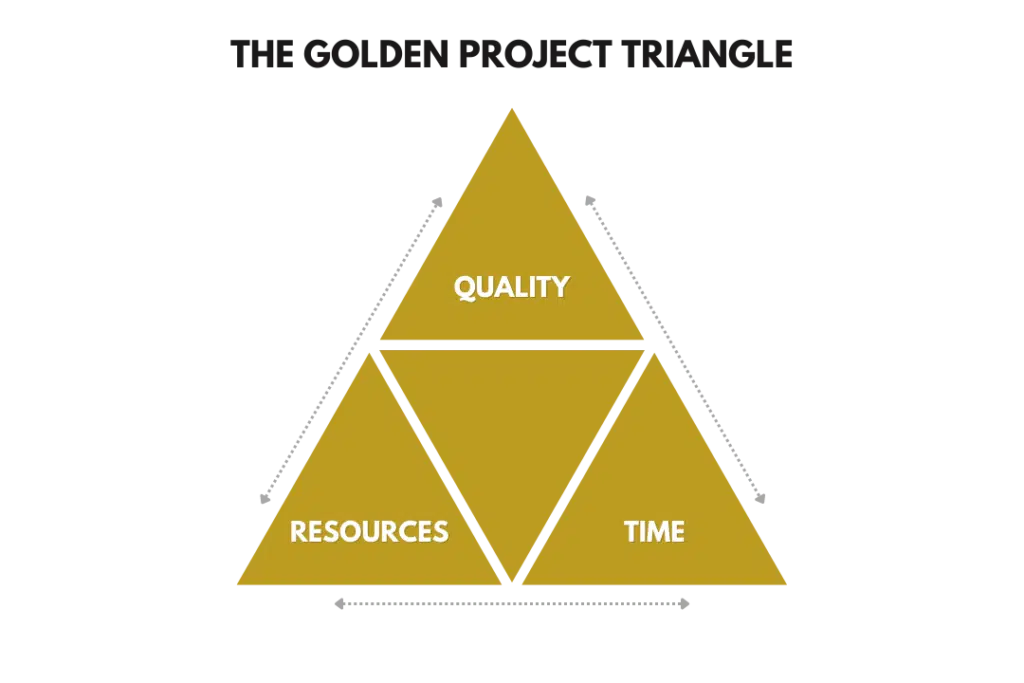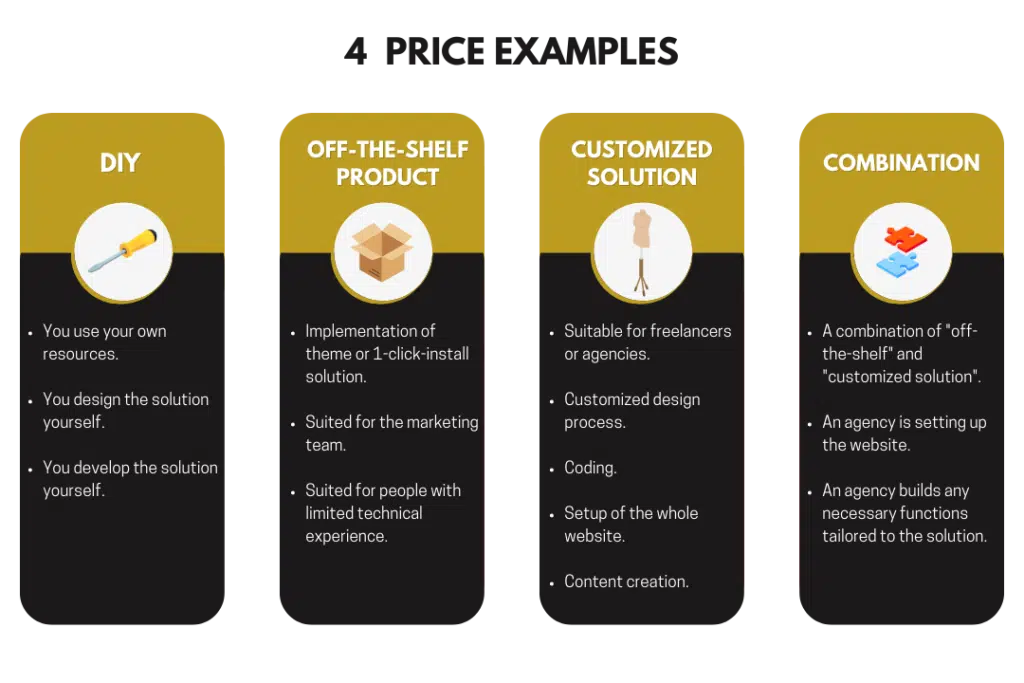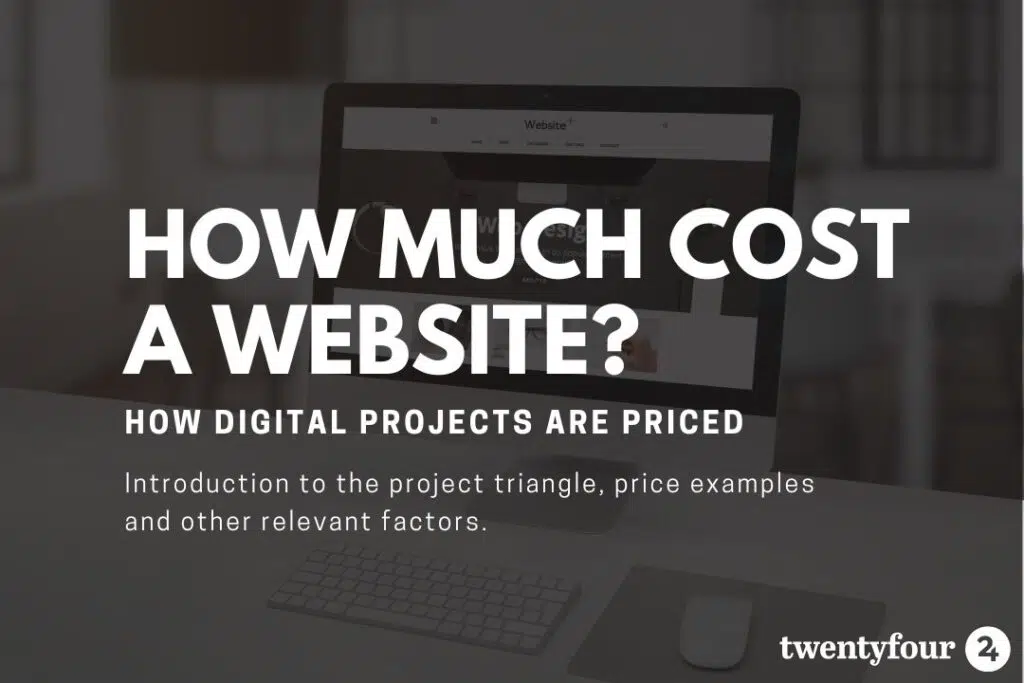How much does a website actually cost?
It’s a question I’m asked often! In this article, I will try to shed light on the various parameters at play when we, at Twentyfour, price a website. Or, in fact, any digital project.
Before diving into the specifics of pricing, I want to take a moment to review the golden project triangle that you can apply in any project regarding price, time, and quality.
Three aspects you cannot avoid: time, quality, and resources
These three aspects are interdependent and influence each other regarding projects and pricing. The aspects must be well-balanced to be successful with your project. The prioritization of time, quality, and resources must most often be decided in the initial project before the project team has the necessary insight to make a long-term sustainable decision.
Therefore, it’s crucial that you set time aside for a clarification phase and make sure to spend some time on this. Ultimately, it’s the success of the project that depends on these initial decisions.
When compromise is a premise
In practice, it is impossible to deliver a project without compromising. There is rarely, I would even venture to say never, unimaginable time and resources available in a project, and quality is often the most important aspect for the customer.
Suppose you imagine a triangle where time and resources are scarce, but the expectation of quality is high. In that case, you will be left with a skewed triangle with two small angles and one huge angle — a triangle out of balance.
To restore balance and the project’s likelihood of success, you need to tweak or modify the expectations for quality and content. Otherwise, you must adjust upwards on the two aspects of time and resources.
The project triangle is beneficial to apply throughout the project as a benchmark when the project team, customer, or other stakeholders challenge the project on time, content, or budget.

It’s all about being able to say ‘no’
“Being able to set boundaries for yourself and towards others is important”. This is how Svend Brinkmann writes in his book “No”, in which he proclaims that only programmed robots always say yes. I think there is a certain truth to that.
It is essential to embrace projects with an open mind and see opportunities instead of limitations. But the boundaries of a project are often just as important to understand and recognize as the possibilities. Only when you know your opt-outs and the reason for these can you focus 100% on your options and do this properly.
The danger of saying yes to everything in a project is that the probability of exceeding the budget, delaying the project, or simply keeping a too poor quality in the project is high.
Therefore, I believe our most important role as advisors is to be professionally well-founded to advise the client in making the right choices. Throughout the project, keep asking the project team and customers: why, what, and to whom.
Tell me, what is the point?
No website without a strategy!
The initial dialogue, strategy, and direction are crucial to the solution and pricing. This is where we ask the customer all the in-depth questions – the silly and basic ones.
For example, we ask the customer: “Why do you need a website at all?”. In the clarification phase, it is crucial to identify the customer’s target group and their location.
Likewise, looking at the customer’s other system landscapes is essential to ensure that manual processes and future scalability are considered in the solution from the start.
For me, as a strategic advisor, it is important that we, together with the customer, are completely aligned on where we are going, why we are going there, and how we will get there. I would say it is a basic premise when doing a project together.
Once we have this clarification in place and know where we are going, we can start looking at the timeframe, the budget, and what resources are available in the project.
Here the work with the project triangle starts! In the initial step, the customer is put to the test and must find possible compromises in the solution.
Ask WH-questions
To specify the process with the project triangle, ask yourself WH-question. Ask yourself continuously what value you want from your digital project. In Twentyfour, we often clarify these questions through a requirement specification project in the initial project phase.
- Why do you even need a website?
- What do you want to achieve with a website?
- Which context is it going to be in?
- What are your KPIs and value output?
- Who is your target audience(s)?
So, how much is it?
Below, I describe four different setups related to website solutions and the price range in Twentyfour within each of these.
From template to a comprehensive custom-designed solution

Do-it-yourself (DIY)-solution
In a DIY website project, you only use your resources. This relates to both the development and design process. Your developers build the solution from scratch, and all content is created by yourself or your employees. With this solution, there is no to either templates or consultants. The expense lies solely in the time of your employees.
As most people know, time is money. Be aware of the cost of such a website project when you estimate your employees’ hours spent on the website versus the quality of the solution and the actual value it creates.
It can be healthy to look into other tasks your employees could solve within the same timeframe – to evaluate if the investment makes sense.
“Off-the-shelf”-solution
In our view, an off-the-shelf solution is a solution where you buy a website template and build the structure of your sites and the content from scratch.
It is a simple solution called an “off-the-shelf-product”. This is because the frame and functions of the various elements have already been built and tested. Several things apply in the solution with an off-the-shelf product. The price can be kept down, the templates are ready for use, and the structure of the various elements is already well-functioning and tested.
On the other hand, you are easily held back by the limited functions available on the template and limited design options. The price ranges from DKK 500-1.000 and upwards, plus the time your employees need to build the structure on your sites and create the content from scratch.
Depending on how extensive your site should be, this solution may take a long time to build from scratch. Even if you use a template.
Suppose you need a small business card website where customers can easily find your services and contact information. In that case, this solution can be pretty nice and relatively inexpensive, as there are no costs for consultants or developers.
The tailored and custom-designed solution
In the custom-designed solution, there are unlimited opportunities. This solution is undoubtedly the most expensive one as it is time-consuming.
When developing a solution tailored to the customer’s needs, we include, e.g., designers who will help create the right look and feel following the customer’s design profile (digital CVI).
All the different elements that have to have their little custom touch must go through a creative process and technical development, and it takes time.
I want to stress the aspect of time here because a customer at Twentyfour pays for the time we spend building the project. We always want to deliver a high-quality solution and create value for every penny the customer spends on the project. Still, it takes time and becomes a more expensive solution with a custom-designed website.
The price can vary widely according to the scope of the website. This is where a dialogue with the customer about the budget is essential so that we get to build a website that creates the most significant value within the available framework. Then you can always add other aspects to the website later on.
The combination solution
The advantage of this solution is that in consultation with the customer, we can dive into different elements on the website and elaborate on which existing elements can be used in the new project.
In many projects, it makes sense to apply existing elements. We can customize the solution by creating a more inviting layout and adapting the solution to the customer’s expressions, needs, and requirements.
In general, it does not make sense to invent the wheel when already existing functions work well and are relatively easy to implement and design for the customer’s solution.
It is cheaper to develop and continue the work on existing frameworks and functions when it comes to a more affordable solution. But still with the opportunity to use its design, expressions, and functions in a combined solution.
The price of this digital solution differs from the custom-designed solution above. The combined solution is usually cheaper than the 100% custom-designed and developed solution. But again, the clarification phase with the customer is important because this is where we uncover what value the site should perform and how we deliver it best.
There is no reason to build everything from scratch if you can take it off the shelf and build on it from a good foundation. Of course, if the customer is comfortable with what is being built isn’t necessarily wholly tailored to them.
A visual example of how quality costs time
Can a digital project be organic?
Yes! In a digital project, there are different phases to go through with the customer. Customers can rarely afford to buy the most optimal solution at once. Moreover, it is not necessarily the best way to do it.
During our projects, we use the phases to stop and assess whether what we are working on still makes sense. Sometimes, we get confirmation that we are on the right track. In other cases, we can elevate the solution as new opportunities might have emerged in the process.
For us, it is important to see the project as organic as modifications in requirements or needs may occur further into the project.
Keeping the triangle in mind
A website project is always an investment. The investment can be small, medium, or large, but it is always an investment, not just an expense. The value that the website creates must be visible on the bottom line.
Another example could be that you spend 1 million DKK on building a new website integrated with 5 systems. With an investment of this size, I can almost guarantee that you will save a lot of time spent on manual processes in the long run. Time is crucial because you can optimize your work areas and allocate your employees to more important tasks than manual processes.
If there is an opportunity with a comprehensive solution to optimize some of your business processes, it is an investment and can save you time.
It is also important to mention that the order of magnitude of our customers’ investment, e.g., a website, is not decisive for how important a customer you are to us. For us, the most important thing is that you as a customer achieve the desired value with your digital project through our work and that your investment pays off.
5 important takeaways you should keep in mind
Below, I will summarize and introduce a few concluding questions that I think are worth asking yourself and your company before embarking on your next digital project.
#1: Keep track of your priorities
Time: How much time do we have for the project? Is there a deadline? Is this fixed or flexible? Can we compromise?
Resources: Do we have internal forces that can use either code, set up the website, design, or create content for our website? Should we consider having done it all with one supplier? What budget is our budget? Can we compromise on price or our resources?
Quality and content: What solution do we expect in the end? Can we compromise on the overall solution and prepare it in, for example, different stages? Which parts of the solution are need-to-have and nice-to-have.
#2: Tailored and custom-designed solution or template?
Be aware of all the great website solutions available on the market today. Do thorough research to find out which setup and templates already exist that your website can draw inspiration from. Also, please pay attention to the foundation on which you build your website in relation to it being sufficiently scalable and thus future-proof.
Ask yourself why you need the website, what exact value it should generate, and how, and then build it accordingly.
#3: Your digital system landscape
Please give it a check. It might be here your most significant profits are hiding!
How are your daily and manual processes today? Can you use your employees’ or your own time for more value-creating tasks than entering and maintaining? What opportunities are there in the market to tie your system landscape together and create a seamless process?
#4: Freelancer or agency?
There are several different types of providers within digital solutions. A freelancer is often far cheaper than agencies. On the other hand, you achieve a greater emphasis on business logic, know-how, and, most importantly, security if you choose a digital agency to handle your task. Agencies have many employees, which secures a higher guarantee of delivery if unforeseen challenges occur, e.g., illness. But it is a trade-off that you should consider every time you face a project that needs to be solved.
#5: Keep in mind that sometimes it costs money to make money, and it costs money when investing in sub-optimizing
If this article leads to any questions or you want to leave a comment, you are more than welcome to email us directly at info@twentyfour.dk.
You are also most welcome to call us on +45 42 41 61 60 for a casual chat, a virtual cup of coffee, or a walk & talk if you want to hear more or discuss a digital project.




